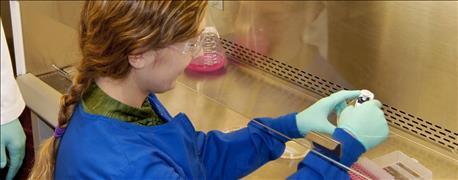January 11, 2016

A swine flu virus, previously only detected in Asia, has been identified in the U.S. by researchers in the Kansas State University Veterinary Diagnostic Laboratory. The researchers successfully published the first formal identification and characterization of porcine parainfluenza virus 1 from U.S. pigs.
The researchers, Benjamin Hause, an assistant professor in the College of Veterinary Medicine, and Rachel Palinski, doctoral student in diagnostic medicine and pathobiology, received diagnostic samples from sick pigs in multiple states, according to Hause.

VIRUS IDENTIFIED: Reseearchers at Kansas State University have identified a swine virus previously only seen in Asia in muliple samples from U.S. pigs
He said the common agents are usually influenza or procine reproductive and respiratory syndrome virus, but the samples were negative for both.
"To identify other possible viruses present in the samples, we utilized advanced DNA sequencing methods, and the common finding was porcine parainfluenza virus 1. It's the first formal identification of this relatively newly described virus in the U.S. We were also surprised to find there is considerable genetic variability for porcine parainfluenza virus 1 between the different samples. They're not all identical viruses. There are mutants and probably different subtypes in the U.S., so there is genetic variation no one knew about before."
Hause said the Veterinary Diagnostic Laboratory developed PCR — polymerase chain reaction — tests and diagnostic assays specifically for this parainfluenza virus.Hause and Palilnski worked with a team of scientists that published its findings in the Nov. 17, 2015, issue of the Journal of General Virology in the article "Widespread detection and characterization of porcine parainfluenza virus 1 in pigs in the United States."
"We screened 300 random samples, including nasal swabs, lung tissue or oral fluids, and found that 6 percent tested positive for the parainfluenza virus," Hause said. "We were also able show that the virus replicates in the upper respiratory tract. We then developed a serology assay to look for antibodies to see how common it is for pigs to have been exposed to this, and about 50-60 percent of the samples were positive. This suggests the virus did not just arrive here or that it is in just one area of the country."
Hause said demand is building for the development of a vaccine.
"Talking to swine veterinarians, this virus is something that likely causes respiratory disease in pigs," Hause said. "It does not typically cause severe disease, but it's the kind of disease that causes an infected pig to fall behind. A pig will get a mild cold, won't eat as well, wean as fast or take off like its litter mates, so there is likely economic significance with the disease."
You May Also Like




